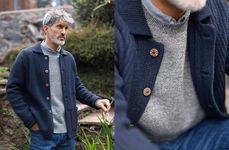
The Shwop Coat is the Result of Marks & Spencer's Shwopping Scheme
Meghan Young — October 16, 2012 — Eco
References: social.marksandspencer & psfk
The Shwop Coat was created with the help of a lot of people, not just the design team over at Marks & Spencer. Part of the British retailer's shwopping scheme with Oxfam, the Shwop Coat is the result of countless of customers' donations earlier in the year. Essentially a recycling initiative, shwopping encouraged people to trade in their old clothes for new ones. Instead of creating more art installations, Marks & Spencer created the Shwop Coat.
The recycled clothes were reduced to fibre form, cleaned and made into new fabric to create the Swop Coat. Consisting of 63% wool, 26% nylon, 8% cashmere and 3% other fibers, it takes on a peacoat style, which is perfect for the fall and winter seasons.
The recycled clothes were reduced to fibre form, cleaned and made into new fabric to create the Swop Coat. Consisting of 63% wool, 26% nylon, 8% cashmere and 3% other fibers, it takes on a peacoat style, which is perfect for the fall and winter seasons.
Trend Themes
1. Recycled Clothing - Disruptive innovation opportunity in the fashion industry by transforming old clothes into new fabric.
2. Shwopping Scheme - Disruptive innovation opportunity in retail by implementing a clothing exchange program.
3. Sustainable Fashion - Disruptive innovation opportunity in the fashion industry by promoting environmentally-friendly apparel.
Industry Implications
1. Fashion - Opportunity for clothing brands to incorporate recycling initiatives into their production processes.
2. Retail - Opportunity for retailers to implement clothing exchange programs to encourage sustainability.
3. Textile - Opportunity for textile manufacturers to develop new fabric using recycled clothing materials.
2.1
Score
Popularity
Activity
Freshness























